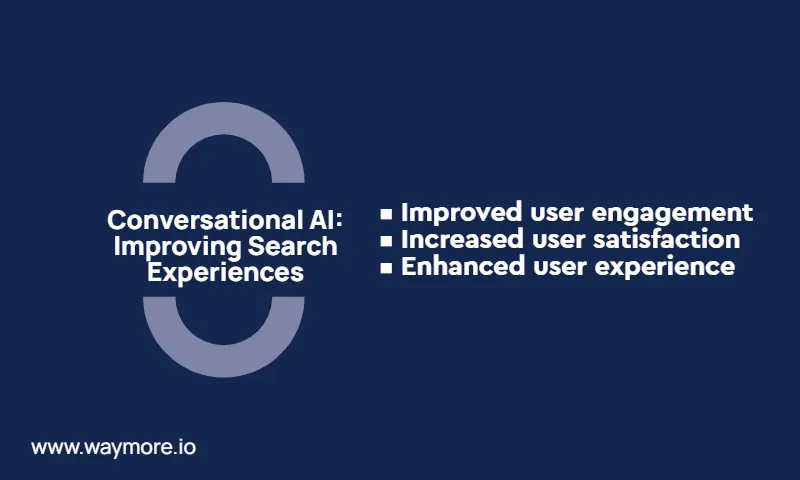Quick Links
Conversational AI is a technology that enables natural language interactions between humans and machines. It allows users to communicate with chatbots, virtual assistants, and other AI-powered applications using voice search or text. Conversational AI is transforming the way people search for information, products, and services online.
What is Conversational AI?
It is a technology that enables natural language interactions between humans and machines. It allows users to communicate with chatbots, virtual assistants, and other AI-powered search engine applications using voice or text.
Conversational AI uses artificial intelligence, machine learning models, and natural language search processing to understand what users are searching for. It analyzes the intent and context of the search input to generate relevant output in natural language. It can handle complex, ambiguous, or long-tail queries and provide answers, solutions, or alternatives. It can also adapt to the user’s feedback, preferences, and behavior and provide suggestions, recommendations, and guidance.
Businesses integrate Conversational AI with various search engines and platforms to offer conversational search interfaces. Users can access these interfaces through voice search technology or text, depending on their preference and device. Conversational AI gathers information from websites, databases, social media, and user profiles to provide up-to-date details.
Impact of Conversational AI on search experiences
Representing a revolutionary and exciting technology, Conversational AI presents numerous opportunities and benefits for both users and businesses.
Better user engagement
Conversational AI provides personalized responses and suggestions, making search experiences more interactive and captivating for users. Additionally, it establishes rapport and trust through the use of humor, emotion, and personality.
Increased user satisfaction
Conversational AI delivers precise responses to users’ queries, handling complex, unclear, or detailed questions effectively by offering answers, solutions, or alternatives. Additionally, it enhances convenience and flexibility for users, enabling them to search using voice or text, anytime and anywhere.
Enhanced user experience
Conversational AI enhances user experience by simplifying search interfaces. It utilizes natural language, images, videos, and other media to display results in a more appealing and understandable manner. This makes it easier for users to interact with the search interface and find the information they are looking for.
Improved usability and search function
Additionally, the use of Conversational AI helps to improve the overall usability and effectiveness of search functions on websites and applications. Conversational AI can sound more human by using voice recognition, speech synthesis, and sentiment analysis for better interactions.
Conversational AI introduces challenges and risks that necessitate addressing and managing. Conversational interfaces not only affect technology but also influence culture and mindset, shaping the future of online search.
Impact of Chatbot AI on search experiences
Chatbot AI is transforming search experiences. Consider imagining a conversational search platform! These chatbots understand natural language, allowing you to ask questions and get clear, concise answers. They can personalize your experience by analyzing past searches and offering relevant information or recommendations.

This can be a huge time-saver, letting you bypass long lists of search results. However, it’s important to note that chatbot AI is still under development. While some can handle complex queries, others might struggle. Chatbot AI is improving search by making it more interactive and efficient, potentially changing how we find information.
Conversational AI for user engagement
Conversational AI uses chatbots, voicebots, and smart assistants to engage with customers using natural language for user interaction. Conversational AI can provide personalized, convenient, and engaging experiences for users across various channels and platforms. Conversational AI can also help businesses improve customer satisfaction, loyalty, and retention.
1. Effortless Accessibility and 24/7 Availability
Operating continuously without breaks, Conversational AI stands out from traditional customer service channels. Chatbots remain accessible 24/7, ready to address queries, fulfill tasks, or provide guidance. This round-the-clock availability proves invaluable for users seeking information or assistance beyond standard business hours.
2. Simplified Communication and Streamlined Tasks
Eliminating the complexity commonly found in navigating menus or websites, Conversational AI offers a seamless experience. Through natural language, users can effortlessly pose questions, seek information, or trigger actions, streamlining tasks and conserving time. This enables users to concentrate on their priorities with ease.
3. Personalized Interactions and Tailored Recommendations
Through interactions and preferences, conversational AI has the ability to learn. This enables the provision of personalized recommendations for products, services, or information. Picture a virtual shopping assistant that remembers your size and style preferences. It can help you find the perfect items.
Additionally, envision a travel chatbot that recommends destinations based on your previous trips. It can provide personalized suggestions for your next vacation.
4. Increased Efficiency and Productivity
Automating repetitive tasks like scheduling appointments, booking reservations, or placing orders is a key function of Conversational AI. This time-saving feature enables users to allocate their time to more meaningful activities.
5. Enhanced CX and Improved Satisfaction
Offering immediate support and answers to frequently asked questions is a notable capability of Conversational AI. This minimizes frustration and waiting times, resulting in a more positive customer experience. Furthermore, chatbots excel in collecting feedback and conducting sentiment analysis, assisting businesses in enhancing their services.
6. Increased Accessibility for Users with Disabilities
For users with visual or physical impairments, Conversational AI presents alternative communication methods. Text-based chatbots or voice assistants enhance accessibility to information and services, promoting greater inclusion.
7. Language Learning and Educational Support
As a language learning aid, Conversational AI proves invaluable. By talking to chatbots that act like real people, users can practice speaking and understanding in a fun way. Likewise, educational chatbots offer personalized learning experiences and address inquiries on diverse topics.
8. Constant Learning and Improvement
Continuously evolving, the capabilities of Conversational AI advance with each interaction. By interacting with more users, these systems improve their ability to understand language and give better responses. This ongoing learning process guarantees users an increasingly sophisticated and beneficial AI experience.
Conversational AI benefits for businesses
Cost-effective
Utilizing natural language processing, machine learning, and cloud computing technologies, Conversational AI offers cost-saving benefits in developing, maintaining, and updating search engines. Chatbot AI reduces the need for humans by giving automatic and accurate answers to user questions.. This can lead to increased customer satisfaction with the overall experience.

Greater Scalability
Conversational AI can handle a high volume of inquiries simultaneously, ensuring consistent customer service as your business grows. This allows you to scale your operations without significant increases in human resources.
Increased Sales and Lead Generation
Employing Conversational AI enables the qualification of leads, customization of product recommendations, and facilitation of sales conversations. This focused strategy aids in the conversion of website visitors into paying customers, thereby stimulating sales and revenue expansion..
Profitable
They can help businesses increase their revenue, by attracting, retaining, and converting more customers. Chatbot search can help businesses increase customer journey value. This involves offering personalized offers, recommendations, or promotions. These rely on user behavior, preferences, and feedback.
Data-Driven Insights and Improved Decision Making
Through interactions, Conversational AI collects valuable customer data, enabling businesses to analyze insights on customer needs, preferences, and buying behavior. This empowers businesses to make data-driven decisions, personalize marketing campaigns, and enhance product offerings in the long run.
How does conversational AI work in search?
We can divide the process of conversational AI in search into 4 main steps:
1. Input generation
The user initiates the search by typing or speaking their query. The query can be a simple keyword, a phrase, or a question. The machine converts the query into a format it can understand, such as text or audio.
2. Input analysis
The machine analyzes the input using natural language processing (NLP) and machine learning (ML) techniques. It extracts the meaning, intent, and context of the query. It also identifies the type, domain, and scope of the query. When a user inquires about the weather in Paris, the machine identifies the question as weather-related. This falls under the geography domain and is specifically about Paris.
3. Output generation
The machine generates an output based on the input analysis. It searches for key information from websites, databases, social media, and user profiles to find the most important details. It also uses natural language generation (NLG) to create a natural and human-like response. If you ask about the weather in Paris, the machine will tell you it’s sunny and warm today.
4. Output delivery
The machine delivers the output to the user in the preferred format and channel. The output can be text, audio, image, video, or a combination of them. The output can also include suggestions, recommendations, or guidance for the user. For example, if the user asks “What is the weather in Paris?”, the machine may also suggest “You may want to visit the Eiffel Tower or the Louvre Museum while you are there.”
The Future of Conversational search with AI
Conversational AI is a technology that enables natural language interactions between humans and machines. It allows users to communicate with chatbots, voicebots, and smart assistants using voice or text.
Here are some of the key aspects that we can expect to see in the future of conversational AI:
Intelligent conversational AI
Conversational AI will become more advanced and intelligent with the progress of artificial intelligence in conversational search(AI), machine learning (ML), and natural language processing (NLP). AI can learn from your interactions and provide personalized responses. It can adapt based on what you say and do. This allows for more tailored communication with the AI. AI will understand user emotions, tone, and personality for more empathetic interactions that feel human-like.
Diverse conversational AI
Conversational AI will become more diverse and inclusive with the support of various languages, cultures, and demographics. Conversational AI can provide search experiences in different languages and cultures, catering to various age groups, genders, and backgrounds. Conversational AI can help users by providing voice-to-text, text-to-voice, and text-to-speech features. This improves accessibility and usability.
Omnichannel conversational AI
Conversational AI will improve by combining different search engines, platforms, and devices for a more seamless experience. Conversational AI can search across different platforms and devices for users. It can also connect with different data sources, apps, and services.
Conversational AI provides users with different ways to search, such as voice, text, image, video, or gestures. This creates a seamless omnichannel experience.
Conversational AI applications in search optimization
Conversational AI apps like chatbots and voicebots help make search engines better by improving performance and relevance. Conversational AI helps search engines understand and respond to user’s natural language queries, giving personalized and contextualized results. Conversational AI can improve search engine performance and user experience by optimizing ranking, indexing, and crawling processes.
Increased search efficiency and scalability
Conversational AI can help search engines optimize their ranking, indexing, and crawling processes, as it can leverage various data sources, such as web pages, databases, social media, and user profiles, to provide comprehensive and up-to-date information. Conversational AI uses machine learning chatbots and artificial intelligence to learn from user feedback, behavior, and preferences. This allows it to provide personalized responses.
Enhanced search experience and engagement
By leveraging Conversational AI, search engines can enhance their interfaces, making them more user-friendly and intuitive. This technology employs natural language, images, videos, and other multimedia elements to present results in a more appealing and understandable manner. Additionally, it offers suggestions, recommendations, and guidance to aid users in exploring further information and options. Moreover, Conversational AI utilizes humor, emotion, and personality to establish rapport and trust with users.
Conversational AI improves search engines by using words, pictures, videos, and more to display results clearly, enhancing user experience. It gives suggestions and guidance to help users find more information and options. It can also use humor, emotion, and personality to build rapport and trust with the user.
Conclusion
In conclusion, the combination of conversational AI and chatbot technology marks a new phase in search capabilities. Businesses are transforming how information is accessed and processed by leveraging chatbot AI to provide users with personalized and intuitive search experiences.
These tools and technologies are readily available.
This simplifies search procedures but also boosts user engagement and satisfaction. With WayMore at the forefront, we can expect even greater advancements in search functionality, shaping the future of how we interact in the digital world.
If you want to learn more, reach out to the experts at WayMore today.




